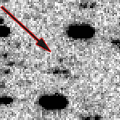
|
It approached to Sun down to 0.1 a.u. on Jan. 31. In the Northern Hemisphere, it will appear in the morning sky soon, then it stays observable while the comet will be fading. In the Southern Hemisphere, it is not observable until mid February.
Date(TT) R.A. (2000) Decl. Delta r Elong. m1 Best Time(A, h)
Feb. 4 20 30.17 -8 4.5 0.965 0.213 12 4.6 5:30 (276, -6)
Feb. 11 20 12.47 -6 26.2 1.157 0.442 22 8.8 5:25 (280, 3)
|
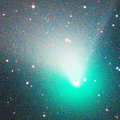
|
Now it is very bright as 5.0 mag (Jan. 28, Osamu Miyazaki). Now it is approaching to Earth down to 0.29 a.u. In the Northern Hemisphere, it stays observable in excellent condition for a long time. It is observable in good condition after this also in the Southern Hemisphere.
Date(TT) R.A. (2000) Decl. Delta r Elong. m1 Best Time(A, h)
Feb. 4 5 29.10 57 48.1 0.294 1.169 122 5.0 20:27 (180, 70)
Feb. 11 4 48.14 26 11.0 0.419 1.209 112 5.9 19:23 ( 0, 80)
|

|
Now it is very bright as 8.6 mag (Jan. 25, Chris Wyatt). It is observable at 8 mag for a long time from 2022 to 2023. In the Southern Hemisphere, it stays observable for a long time. In the Northern Hemisphere, it is not observable until summer.
Date(TT) R.A. (2000) Decl. Delta r Elong. m1 Best Time(A, h)
Feb. 4 23 18.24 -69 43.5 2.240 1.892 56 7.8 18:57 ( 21,-25)
Feb. 11 0 17.45 -67 28.5 2.228 1.921 59 7.9 19:03 ( 22,-22)
|
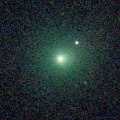
|
It brightened very rapidly. Now it is very bright as 9.9 mag (Jan. 27, Osamu Miyazaki). It stays 9-10 mag until March. In the Northern Hemisphere, it stays observable for a long time. But it locates low until spring. In the Southern Hemisphere, it is not observable until June.
Date(TT) R.A. (2000) Decl. Delta r Elong. m1 Best Time(A, h)
Feb. 4 20 4.23 58 16.8 1.700 1.745 75 9.5 5:30 (218, 32)
Feb. 11 20 54.93 56 50.0 1.775 1.738 71 9.6 5:25 (218, 28)
|
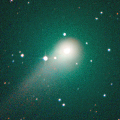
|
Now it is 10.6 mag (Jan. 28, Osamu Miyazaki). It stays bright as 10 mag for a long time until autumn. In the Northern Hemisphere, it stays observable in good condition until autumn. In the Southern Hemipshere, it stays unobservable until summer.
Date(TT) R.A. (2000) Decl. Delta r Elong. m1 Best Time(A, h)
Feb. 4 1 30.61 54 49.7 2.263 2.471 90 9.7 18:57 (140, 59)
Feb. 11 1 34.08 50 35.6 2.353 2.438 83 9.7 19:03 (130, 55)
|
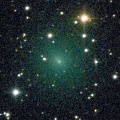
|
It brightened very rapidly. Now it is very bright as 9.6 mag (Jan. 25, Toshihiko Ikemura, Hirohisa Sato). It stays 10-12 mag until February. In the Northern Hemisphere, it stays observable in good condition. Appearing in the evening sky also in the Southern Hemisphere. It stays observable in excellent condition after this.
Date(TT) R.A. (2000) Decl. Delta r Elong. m1 Best Time(A, h)
Feb. 4 4 50.37 47 8.0 0.576 1.363 119 11.5 19:56 (180, 79)
Feb. 11 5 15.71 36 0.9 0.617 1.390 118 11.8 19:53 (180, 90)
|

|
Now it is 13.2 mag (Nov. 27, Ken-ichi Kadota). It is expected to brighten up to 11 mag in 2023. In the Southern Hemisphere, it stays observable in good condition for a long time, although it became unobservable temporarily from November to January. In the Northern Hemisphere, it is not observable until 2024 autumn.
Date(TT) R.A. (2000) Decl. Delta r Elong. m1 Best Time(A, h)
Feb. 4 19 3.22 -30 57.4 4.002 3.208 31 11.6 5:30 (306, -3)
Feb. 11 19 11.40 -32 15.2 3.915 3.189 37 11.5 5:25 (309, -1)
|

|
It brightened up to 8.3 mag in last winter (Jan. 6, 2022, Toshiyuki Takahashi). Now it is fading. But it is bright as 11.1 mag still now (Jan. 14, Thomas Lehmann). It is observable in excellent condition in the Southern Hemisphere. It locates low in the Northern Hemisphere.
Date(TT) R.A. (2000) Decl. Delta r Elong. m1 Best Time(A, h)
Feb. 4 9 35.29 -34 40.2 4.278 4.952 128 11.6 0:42 ( 0, 20)
Feb. 11 9 30.12 -35 1.4 4.293 4.993 130 11.7 0:09 ( 0, 20)
|
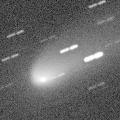
|
Now it is 11.4 mag (Jan. 27, Toshihiko Ikemura, Hirohisa Sato). It stays 11-12 mag until spring.
Date(TT) R.A. (2000) Decl. Delta r Elong. m1 Best Time(A, h)
Feb. 4 16 0.32 -17 27.7 1.671 1.674 73 11.8 5:30 (333, 33)
Feb. 11 16 16.75 -18 1.6 1.635 1.696 76 11.8 5:25 (334, 33)
|
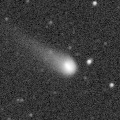
|
Now it is 12.3 mag (Jan. 25, Osamu Miyazaki). It stays 12 mag until summer. It stays observable in good condition for a long time.
Date(TT) R.A. (2000) Decl. Delta r Elong. m1 Best Time(A, h)
Feb. 4 13 31.84 1 4.6 3.152 3.657 113 12.2 4:38 ( 0, 56)
Feb. 11 13 23.78 0 38.8 3.027 3.649 122 12.1 4:02 ( 0, 56)
|
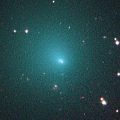
|
Now it is bright as 11.4 mag (Dec. 14, Jose Guilherme de S. Aguiar). It will be fading after this. In the Southern Hemisphere, it stays observable in good condition for a long time, although it became unobservable temporarily from December to January. In the Northern Hemisphere, it is not observable until spring when it fades down to 15 mag.
Date(TT) R.A. (2000) Decl. Delta r Elong. m1 Best Time(A, h)
Feb. 4 19 24.56 -38 28.2 2.580 1.816 31 12.8 5:30 (310,-11)
Feb. 11 19 22.84 -38 47.2 2.531 1.859 38 13.1 5:25 (313, -8)
|
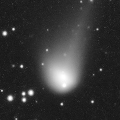
|
Now it is bright as 12.9 mag (Jan. 27, Toshihiko Ikemura, Hirohisa Sato). It stays 13 mag until spring. It stays observable in good condition for a while after this.
Date(TT) R.A. (2000) Decl. Delta r Elong. m1 Best Time(A, h)
Feb. 4 15 31.83 3 5.4 4.660 4.682 85 12.9 5:30 (330, 54)
Feb. 11 15 35.56 4 6.9 4.582 4.707 91 12.9 5:25 (337, 57)
|
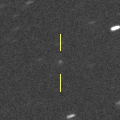
|
It brightens up to 13 mag in winter. But the condition is bad. Appearing in the morning sky in the Southern Hemisphere. It is not observable until May in the Northern Hemisphere.
Date(TT) R.A. (2000) Decl. Delta r Elong. m1 Best Time(A, h)
Feb. 4 19 30.05 -25 31.0 2.436 1.593 24 13.2 5:30 (298, -4)
Feb. 11 19 53.05 -25 0.8 2.421 1.599 26 13.2 5:25 (298, -4)
|
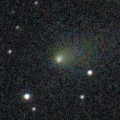
|
Now it is 13.0 mag (Jan. 21, Ken-ichi Kadota). It stays bright as 13 mag and observable in excellent condition until February.
Date(TT) R.A. (2000) Decl. Delta r Elong. m1 Best Time(A, h)
Feb. 4 8 28.87 14 41.9 0.949 1.927 170 13.2 23:31 ( 0, 70)
Feb. 11 8 25.73 16 2.7 0.981 1.946 162 13.4 23:01 ( 0, 71)
|
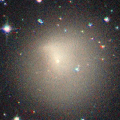
|
It brightened in major outburst in late November. Now it is bright as 11.6 mag (Jan. 18, Toshihiko Ikemura, Hirohisa Sato).
Date(TT) R.A. (2000) Decl. Delta r Elong. m1 Best Time(A, h)
Feb. 4 6 21.07 29 3.3 5.283 6.068 139 13.5 21:24 ( 0, 84)
Feb. 11 6 19.05 28 54.9 5.362 6.070 132 13.5 20:55 ( 0, 84)
|

|
Now it is 13.8 mag (Jan. 20, Ken-ichi Kadota). The brightness evolution is slower than originally predicted. It stays 14 mag until summer. In the Northern Hemisphere, it will too low to observe in late March. In the Southern Hemisphere, it stays observable in good condition for a long time.
Date(TT) R.A. (2000) Decl. Delta r Elong. m1 Best Time(A, h)
Feb. 4 3 15.21 -12 42.3 2.085 2.276 88 13.6 18:57 ( 12, 41)
Feb. 11 3 16.22 -13 55.2 2.155 2.240 81 13.6 19:03 ( 22, 38)
|
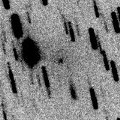
|
Tiny comet, but it will approach to Sun down to 0.8 a.u. in January, and to Earth down to 0.6 a.u. in March. It will brighten up to 14 mag from January to March. In the Southern Hemisphere, it stays observable in good condition for a long time. In the Northern Hemisphere, it is not observable until early March. It has not been observed since late October.
Date(TT) R.A. (2000) Decl. Delta r Elong. m1 Best Time(A, h)
Feb. 4 23 21.89 -62 44.5 1.016 0.875 51 14.0 18:57 ( 27,-21)
Feb. 11 0 27.87 -64 52.7 0.892 0.920 58 13.9 19:03 ( 23,-20)
|

|
Now it is 15.7 mag (Jan. 26, ATLAS Chile). It will brighten very rapidly. It is expected to be observable at 11 mag in excellent condition from spring to summer.
Date(TT) R.A. (2000) Decl. Delta r Elong. m1 Best Time(A, h)
Feb. 4 16 51.76 -25 36.3 2.453 2.138 59 14.7 5:30 (325, 20)
Feb. 11 17 7.80 -25 31.1 2.367 2.119 63 14.3 5:25 (326, 21)
|
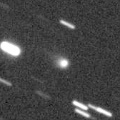
|
Now it is 14.7 mag (Jan. 11, Hiroshi Abe). It is expected to brighten up to 8 mag in July. It will be unobservable soon. In the Southern Hemisphere, it will be observable in excellent condition at the high light. In the Northern Hemisphere, it becomes very low at the high lihght.
Date(TT) R.A. (2000) Decl. Delta r Elong. m1 Best Time(A, h)
Feb. 4 0 22.11 -13 4.2 3.340 2.762 46 14.5 18:57 ( 56, 21)
Feb. 11 0 21.60 -12 47.5 3.370 2.693 40 14.4 19:03 ( 62, 15)
|
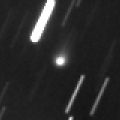
|
Now it is 14.7 mag (Jan. 13, ATLAS Chile). It stays 14 mag in 2023. In the Southern Hemisphere, it stays observable in good condition for a long time. It locates somewhat low in the Northern Hemisphere.
Date(TT) R.A. (2000) Decl. Delta r Elong. m1 Best Time(A, h)
Feb. 4 2 51.64 -15 11.2 3.403 3.407 81 14.5 18:57 ( 19, 38)
Feb. 11 2 45.99 -13 41.3 3.509 3.386 74 14.5 19:03 ( 31, 36)
|
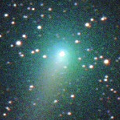
|
It brightened up to 9.3 mag in early summer (June 5, Chris Wyatt). Now it is fading. It has already faded down to 15.0 mag (Jan. 14, Thomas Lehmann). In the Southen Hemisphere, it stays observable in good condition for a long time. It became observable also in the Northern Hemisphere. But it stays locating low for a while.
Date(TT) R.A. (2000) Decl. Delta r Elong. m1 Best Time(A, h)
Feb. 4 7 20.28 -32 34.0 2.690 3.349 124 14.7 22:22 ( 0, 23)
Feb. 11 7 9.49 -29 44.9 2.767 3.413 123 14.9 21:44 ( 0, 25)
|
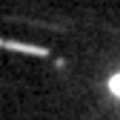
|
Now it is 15.8 mag (Jan. 24, Toshihiko Ikemura, Hirohisa Sato). It will brighten rapidly up to 14 mag and will be observable in excellent condition in spring. In the Northern Hemisphere, it is observable in good condition in winter, but it becomes somewhat low in spring.
Date(TT) R.A. (2000) Decl. Delta r Elong. m1 Best Time(A, h)
Feb. 4 14 21.89 -13 18.4 2.050 2.380 97 15.0 5:27 ( 0, 42)
Feb. 11 14 27.02 -14 50.5 1.956 2.373 102 14.8 5:05 ( 0, 40)
|
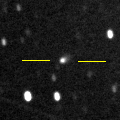
|
Now it is 14.8 mag (Jan. 26, iTelescope Observatory, Siding Spring). It is expected to brighten up to 7 mag in early 2024. In the Southern Hemisphere, it stays observable in good condition for a long time. It locates low in the Northern Hemisphere.
Date(TT) R.A. (2000) Decl. Delta r Elong. m1 Best Time(A, h)
Feb. 4 5 19.32 -37 2.1 4.419 4.757 104 15.0 20:22 ( 0, 18)
Feb. 11 5 16.46 -36 19.2 4.406 4.690 100 14.9 19:52 ( 0, 19)
|

|
Now it is 15.6 mag (Jan. 16, Ken-ichi Kadota). The brightness evolution is slower than originally expected. It stays 14-15 mag for a long time. It stays observable in good condition for a while.
Date(TT) R.A. (2000) Decl. Delta r Elong. m1 Best Time(A, h)
Feb. 4 18 2.70 -5 20.2 3.865 3.269 46 15.0 5:30 (297, 25)
Feb. 11 18 5.36 -3 38.7 3.797 3.299 53 15.0 5:25 (299, 30)
|
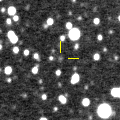
|
Now it is 15.5 mag (Jan. 24, ATLAS Chile). It will brighten up to 13 mag from 2024 to 2025. It is observable in excllent condition in the Southern Hemisphere. It locates low in the Northern Hemisphere.
Date(TT) R.A. (2000) Decl. Delta r Elong. m1 Best Time(A, h)
Feb. 4 8 59.64 -39 28.0 6.026 6.628 124 15.1 0:06 ( 0, 15)
Feb. 11 8 56.65 -39 19.7 5.972 6.595 125 15.0 23:31 ( 0, 16)
|

|
Now it is 14.8 mag (Dec. 8, ATLAS Chile). Now it is not observable. It will become observable again in late March in the Southern Hemisphere, or in late May in the Northern Hemisphere.
Date(TT) R.A. (2000) Decl. Delta r Elong. m1 Best Time(A, h)
Feb. 4 21 46.12 -20 30.3 4.177 3.210 9 15.2 18:57 ( 74,-13)
Feb. 11 21 56.80 -19 36.1 4.198 3.221 7 15.3 19:03 ( 78,-17)
|
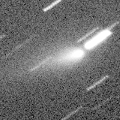
|
Outburst occured in early October, and it brightened up to 9.9 mag (Oct. 14, Thomas Lehmann). It is bright as 13.1 mag still now (Jan. 14, Thomas Lehmann). It stays observable only until February in the Southern Hemisphere, or until March in the Northern Hemisphere.
Date(TT) R.A. (2000) Decl. Delta r Elong. m1 Best Time(A, h)
Feb. 4 0 17.61 -5 27.4 2.736 2.196 47 15.7 18:57 ( 63, 25)
Feb. 11 0 29.87 -3 48.3 2.858 2.256 44 16.0 19:03 ( 68, 23)
|
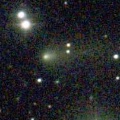
|
Now it is 14.4 mag (Jan. 19, Toshihiko Ikemura, Hirohisa Sato). It will be fading after this, and it will be fainter than 18 mag in spring. It is observable in good condition in the Northern Hemisphere. It locates somewhat low in the Southern Hemisphere. It is brighter than this ephemeris recently.
Date(TT) R.A. (2000) Decl. Delta r Elong. m1 Best Time(A, h)
Feb. 4 7 32.09 24 46.4 1.688 2.620 156 15.7 22:35 ( 0, 80)
Feb. 11 7 28.69 25 8.8 1.750 2.641 148 15.8 22:04 ( 0, 80)
|
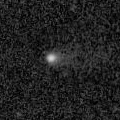
|
Now it is 14.6 mag (Jan. 24, Purple Mountain Observatory, XuYi Station). It stays 15-16 mag and observable in good condition until spring. It is brighter than this ephemeris recently.
Date(TT) R.A. (2000) Decl. Delta r Elong. m1 Best Time(A, h)
Feb. 4 9 31.01 24 52.7 2.395 3.370 170 15.8 0:38 ( 0, 80)
Feb. 11 9 28.59 25 49.9 2.397 3.370 168 15.8 0:08 ( 0, 81)
|
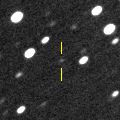
|
Now it is 15.7 mag (Jan. 26, ATLAS Chile). It is expected to brighten up to 12-13 mag from 2024 to 2025.
Date(TT) R.A. (2000) Decl. Delta r Elong. m1 Best Time(A, h)
Feb. 4 9 58.71 -18 16.3 5.371 6.188 143 16.1 1:05 ( 0, 37)
Feb. 11 9 52.36 -17 33.6 5.286 6.144 147 16.0 0:31 ( 0, 37)
|

|
Now it is 15.5 mag (Jan. 13, ATLAS Chile). It was expected to brighten up to 13 mag in 2022 spring. But actually, it was fainter than originally expected. In the Southern Hemisphere, it stays observable in good condition for a long time. In the Northern Hemisphere, it will be unobservable in March.
Date(TT) R.A. (2000) Decl. Delta r Elong. m1 Best Time(A, h)
Feb. 4 2 13.44 -29 4.8 4.046 3.829 70 16.0 18:57 ( 24, 22)
Feb. 11 2 13.15 -26 55.4 4.174 3.867 65 16.1 19:03 ( 32, 21)
|
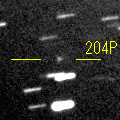
|
It brightened rapidly. Now it is 16.3 mag (Jan. 26, Purple Mountain Observatory, XuYi Station). It is observable at 16 mag in good condition in winter.
Date(TT) R.A. (2000) Decl. Delta r Elong. m1 Best Time(A, h)
Feb. 4 10 13.22 18 39.7 0.994 1.961 164 16.2 1:20 ( 0, 73)
Feb. 11 10 9.15 19 38.0 1.003 1.983 170 16.3 0:48 ( 0, 74)
|
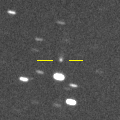
|
It will brighten up to 16 mag in 2023. In the Southern Hemisphere, it stays observable in good condition for a long time. In the Northern Hemisphere, it will never be observable again. It has not been observed since 2022 July.
Date(TT) R.A. (2000) Decl. Delta r Elong. m1 Best Time(A, h)
Feb. 4 16 15.50 -68 36.0 3.470 3.243 68 16.3 5:30 (350,-16)
Feb. 11 16 40.65 -69 55.8 3.424 3.242 71 16.3 5:25 (350,-17)
|

|
It was observed at 15 mag from 2021 to 2022. Now it is fading. In the Southern Hemisphere, it stays observable in excellent condition for a long time. In the Northern Hemiphere, it is not observable after this. It has not been observed since late September.
Date(TT) R.A. (2000) Decl. Delta r Elong. m1 Best Time(A, h)
Feb. 4 15 17.09 -65 24.7 6.271 6.077 74 16.3 5:30 (354,-11)
Feb. 11 15 13.76 -66 41.3 6.215 6.106 79 16.3 5:25 (357,-12)
|
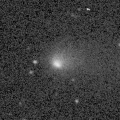
|
It brightened up to 14.6 mag in autumn (Oct. 19, Toshihiko Ikemura, Hirohisa Sato). Now it is fading. It has already faded down to 17.1 mag (Jan. 19, Toshihiko Ikemura, Hirohisa Sato). It will be fainter than 18 mag in spring.
Date(TT) R.A. (2000) Decl. Delta r Elong. m1 Best Time(A, h)
Feb. 4 2 24.46 7 52.7 2.183 2.265 81 16.3 18:57 ( 42, 56)
Feb. 11 2 35.23 8 57.0 2.280 2.283 77 16.5 19:03 ( 51, 54)
|
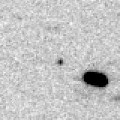
|
Now it is 16.5 mag (Jan. 27, ATLAS Chile). It stays observable at 16 mag for a long time from early 2023 to early 2024. In the Northern Hemisphere, it is observable only until 2023 spring.
Date(TT) R.A. (2000) Decl. Delta r Elong. m1 Best Time(A, h)
Feb. 4 9 43.10 -3 41.1 3.321 4.251 158 16.4 0:50 ( 0, 51)
Feb. 11 9 33.50 -4 24.2 3.275 4.222 161 16.3 0:13 ( 0, 51)
|
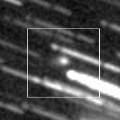
|
Now it is 17.4 mag (Jan. 18, A. Diepvens). It is expected to brighten up to 11.5 mag in 2024 spring. It stays observable in good condition for a long time. It becomes observable after late February also in the Southern Hemisphere. At the high light, it will be observable in excellent condition in the Southern Hemisphere, but it will be low in the Northern Hemisphere.
Date(TT) R.A. (2000) Decl. Delta r Elong. m1 Best Time(A, h)
Feb. 4 18 31.13 14 41.1 5.359 4.781 49 16.4 5:30 (274, 32)
Feb. 11 18 33.27 14 54.8 5.245 4.730 53 16.3 5:25 (277, 36)
|
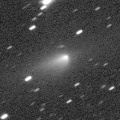
|
It brightened up to 12.7 mag in last year (Feb. 27, 2022, Jose Guilherme de S. Aguiar). Now it is fading. Appearing in the morning sky. In the Southern Hemisphere, it stays observable until summer when it becomes fainter than 18 mag. It locates low in the Northern Hemisphere.
Date(TT) R.A. (2000) Decl. Delta r Elong. m1 Best Time(A, h)
Feb. 4 18 12.24 -25 49.6 3.237 2.588 41 16.4 5:30 (310, 9)
Feb. 11 18 24.92 -25 50.2 3.197 2.611 46 16.4 5:25 (312, 10)
|
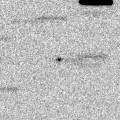
|
Now it is 16.8 mag (Jan. 25, ATLAS-HKO, Haleakala). It is observable at 16.5 mag in good condition from January to March. It locates somewhat low in the Southern Hemisphere.
Date(TT) R.A. (2000) Decl. Delta r Elong. m1 Best Time(A, h)
Feb. 4 12 32.93 26 22.0 0.340 1.238 131 16.5 3:38 ( 0, 81)
Feb. 11 12 54.41 28 2.5 0.344 1.244 132 16.4 3:32 ( 0, 83)
|
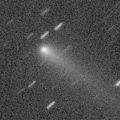
|
It brightened up to 14.1 mag in autumn (Nov. 14, Thomas Lehmann). Now it is fading. It has already faded down to 15.8 mag (Jan. 21, Toshihiko Ikemura, Hirohisa Sato). In the Northern Hemisphere, it stays observable in excellent condition for a while. In the Southern Hemisphere, it will be unobservable soon.
Date(TT) R.A. (2000) Decl. Delta r Elong. m1 Best Time(A, h)
Feb. 4 2 33.14 31 18.3 2.344 2.563 91 16.4 18:57 ( 84, 73)
Feb. 11 2 42.46 32 2.4 2.447 2.583 86 16.6 19:03 ( 90, 68)
|
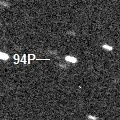
|
Now it is 16.9 mag (Jan. 25, Toshihiko Ikemura, Hirohisa Sato). It is observable at 16.5 mag in good condition in spring. It locates somewhat low in the Southern Hemisphere.
Date(TT) R.A. (2000) Decl. Delta r Elong. m1 Best Time(A, h)
Feb. 4 8 28.45 28 10.8 1.377 2.344 165 16.6 23:31 ( 0, 83)
Feb. 11 8 23.05 28 35.0 1.386 2.330 157 16.6 22:58 ( 0, 84)
|
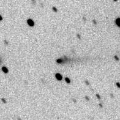
|
Now it is 16.4 mag (Jan. 19, Toshihiko Ikemura, Hirohisa Sato). It is observable at 16-17 mag in excellent condition from autumn to winter.
Date(TT) R.A. (2000) Decl. Delta r Elong. m1 Best Time(A, h)
Feb. 4 4 3.71 0 26.0 3.154 3.516 103 16.6 19:07 ( 0, 56)
Feb. 11 4 6.45 1 0.9 3.253 3.522 97 16.7 19:03 ( 9, 56)
|
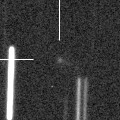
|
Now it is 16.9 mag (Jan. 21, Toshihiko Ikemura, Hirohisa Sato). It will brighten up to 13 mag in summer. In the Northern Hemisphere, it stays observable in good condition for a long time. In the Southern Hemisphere, it is not observable until August.
Date(TT) R.A. (2000) Decl. Delta r Elong. m1 Best Time(A, h)
Feb. 4 9 14.12 75 2.8 1.689 2.358 121 16.9 0:25 (180, 50)
Feb. 11 7 59.19 78 33.5 1.693 2.288 114 16.7 22:29 (180, 46)
|
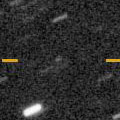
|
Appearing in the morning sky. It stays observable at 14-15 mag from spring to autumn. It locates somewhat low in the Northern Hemisphere.
Date(TT) R.A. (2000) Decl. Delta r Elong. m1 Best Time(A, h)
Feb. 4 17 17.17 -12 13.9 3.634 3.188 55 16.9 5:30 (311, 28)
Feb. 11 17 26.28 -12 37.2 3.535 3.169 60 16.8 5:25 (314, 29)
|
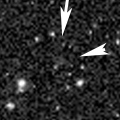
|
Now it is 16.9 mag (Jan. 20, ATLAS Chile). Very far object. It stays 16-17 mag for a long time from 2021 to 2026. In the Southern Hemisphere, it stays observable in good condition for a long time. In the Northern Hemisphere, it is not observable at all.
Date(TT) R.A. (2000) Decl. Delta r Elong. m1 Best Time(A, h)
Feb. 4 5 37.66 -75 36.8 10.506 10.424 82 16.9 20:38 ( 0,-21)
Feb. 11 5 26.94 -75 6.6 10.494 10.419 82 16.9 20:00 ( 0,-20)
|
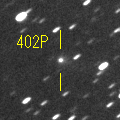
|
It brightened up to 15.3 mag in last winter (Jan. 12, 2022, H. Nohara). Now it is fading. It has already faded down to 17.2 mag (Jan. 28, Toshihiko Ikemura, Hirohisa Sato). It will be observable at 17 mag in good condition in next winter. It locates low in the Southern Hemisphere.
Date(TT) R.A. (2000) Decl. Delta r Elong. m1 Best Time(A, h)
Feb. 4 10 16.00 26 48.5 3.625 4.569 161 17.0 1:23 ( 0, 82)
Feb. 11 10 12.49 27 40.7 3.630 4.587 164 17.1 0:52 ( 0, 83)
|
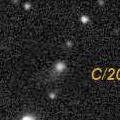
|
Now it is 17.0 mag (Jan. 21, Toshihiko Ikemura, Hirohisa Sato). It stays 17 mag and observable in good condition until summer.
Date(TT) R.A. (2000) Decl. Delta r Elong. m1 Best Time(A, h)
Feb. 4 13 29.22 6 38.5 8.426 8.896 115 17.1 4:35 ( 0, 62)
Feb. 11 13 26.63 7 10.9 8.324 8.901 123 17.1 4:05 ( 0, 62)
|
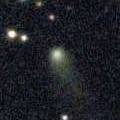
|
Now it is 17.1 mag (Jan. 27, Toshihiko Ikemura, Hirohisa Sato). Fading slowly. In the Southern Hemisphere, it is not observable after this.
Date(TT) R.A. (2000) Decl. Delta r Elong. m1 Best Time(A, h)
Feb. 4 18 4.91 44 37.6 6.246 6.048 73 17.3 5:30 (240, 48)
Feb. 11 18 11.82 45 42.2 6.250 6.080 75 17.3 5:25 (238, 50)
|

|
It brightened very rapidly up to 15.5 mag from last autumn to last winter (Nov. 2, 2021, Toshihiko Ikemura, Hirohisa Sato). Now it is fading slowly. It has already faded down to 16.7 mag (Jan. 19, ATLAS Chile).
Date(TT) R.A. (2000) Decl. Delta r Elong. m1 Best Time(A, h)
Feb. 4 6 12.28 9 44.9 3.807 4.575 136 17.3 21:15 ( 0, 65)
Feb. 11 6 10.89 9 55.8 3.902 4.596 129 17.4 20:46 ( 0, 65)
|

|
Now it is 17.1 mag (Jan. 9, D. Buczynski). Fading slowly. In the Northern Hemisphere, it stays observable in good condition for a long time. In the Southern Hemisphere, it is not observable after this.
Date(TT) R.A. (2000) Decl. Delta r Elong. m1 Best Time(A, h)
Feb. 4 18 17.93 66 40.4 9.659 9.690 88 17.4 5:30 (208, 44)
Feb. 11 18 21.92 67 27.0 9.674 9.706 88 17.4 5:25 (206, 46)
|
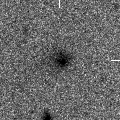
|
Now it is 17.8 mag (Jan. 24, ATLAS Chile). Very large comet. It is expected to brighten up to 14 mag in 2031. In the Southern Hemisphere, it stays observable in good condition for a long time. In the Northern Hemisphere, it is not observable until 2030.
Date(TT) R.A. (2000) Decl. Delta r Elong. m1 Best Time(A, h)
Feb. 4 2 28.07 -59 28.8 18.327 18.027 70 17.4 18:57 ( 11, -6)
Feb. 11 2 28.84 -59 11.7 18.329 18.001 69 17.4 19:03 ( 15, -7)
|
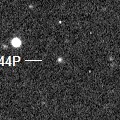
|
Now it is 17.5 mag (Jan. 18, Toshihiko Ikemura, Hirohisa Sato). It is observable at 17 mag in good condition in winter. It locates somewhat low in the Southern Hemisphere.
Date(TT) R.A. (2000) Decl. Delta r Elong. m1 Best Time(A, h)
Feb. 4 5 48.61 26 6.7 3.196 3.932 132 17.4 20:52 ( 0, 81)
Feb. 11 5 47.63 26 1.8 3.278 3.935 125 17.4 20:23 ( 0, 81)
|

|
It has not been observed yet in this apparition. In the last apparition, it had faded before the perihelion passage. If it becomes as bright as its last apparition, it will brighten up to 17 mag. It stays observable in good condition for a long time.
Date(TT) R.A. (2000) Decl. Delta r Elong. m1 Best Time(A, h)
Feb. 4 14 2.01 0 5.7 2.478 2.907 105 17.7 5:08 ( 0, 55)
Feb. 11 14 6.72 0 21.3 2.374 2.888 111 17.6 4:45 ( 0, 55)
|

|
Now it is 17.4 mag (Jan. 18, Toshihiko Ikemura, Hirohisa Sato). It stays 17 mag for a long time from 2023 to 2024. It is observable in good condition in the Northern Hemisphere. It locates low in the Southern Hemisphere.
Date(TT) R.A. (2000) Decl. Delta r Elong. m1 Best Time(A, h)
Feb. 4 2 25.24 27 56.9 6.984 7.029 88 17.6 18:57 ( 76, 70)
Feb. 11 2 27.71 28 2.0 7.081 7.015 82 17.6 19:03 ( 83, 64)
|
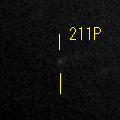
|
Now it is 18.4 mag (Jan. 25, Toshihiko Ikemura, Hirohisa Sato). It brightens up to 17.5 mag from January to February. It locates somewhat low in the Southern Hemisphere.
Date(TT) R.A. (2000) Decl. Delta r Elong. m1 Best Time(A, h)
Feb. 4 12 3.46 20 33.4 1.635 2.461 138 17.7 3:09 ( 0, 75)
Feb. 11 12 2.82 22 1.5 1.605 2.475 144 17.7 2:41 ( 0, 77)
|

|
Now it is 17.6 mag (Jan. 22, iTelescope Observatory, Siding Spring). It is observable at 17.5 mag in good condition in winter.
Date(TT) R.A. (2000) Decl. Delta r Elong. m1 Best Time(A, h)
Feb. 4 8 47.90 -0 13.7 2.545 3.498 162 17.7 23:50 ( 0, 55)
Feb. 11 8 44.43 0 0.8 2.553 3.500 160 17.7 23:19 ( 0, 55)
|
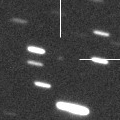
|
Now it is 17.9 mag (Jan. 17, A. Diepvens). It stays 17.5 mag until spring. It is observable in good condition in the Northern Hemisphere. It is not observable in the Southern Hemisphere.
Date(TT) R.A. (2000) Decl. Delta r Elong. m1 Best Time(A, h)
Feb. 4 0 7.81 80 19.1 2.822 3.139 99 17.7 18:57 (170, 40)
Feb. 11 1 9.35 79 49.3 2.838 3.133 98 17.7 19:03 (170, 41)
|

|
It brightened up to 14 mag in 2021. Now it is fading. It has already faded down to 17.2 mag (Jan. 21, Toshihiko Ikemura, Hirohisa Sato). It will be fainter than 18 mag in March. It is already unobservable in the Southern Hemisphere.
Date(TT) R.A. (2000) Decl. Delta r Elong. m1 Best Time(A, h)
Feb. 4 23 33.98 17 31.5 7.496 6.895 49 17.8 18:57 ( 91, 30)
Feb. 11 23 37.38 18 0.6 7.611 6.935 43 17.8 19:03 ( 96, 25)
|
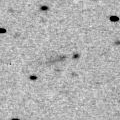
|
Now it is 18.6 mag (Jan. 21, Toshihiko Ikemura, Hirohisa Sato). It stays observable at 18 mag in good condition from January to March.
Date(TT) R.A. (2000) Decl. Delta r Elong. m1 Best Time(A, h)
Feb. 4 10 28.99 13 24.6 3.261 4.202 160 17.8 1:35 ( 0, 68)
Feb. 11 10 26.02 13 51.8 3.228 4.198 167 17.8 1:05 ( 0, 69)
|
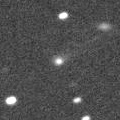
|
It brightened up to 15.9 mag in 2022 spring (May 5, Toshiyuki Takahashi). In 2023, it is observable at 17.5 mag in spring.
Date(TT) R.A. (2000) Decl. Delta r Elong. m1 Best Time(A, h)
Feb. 4 16 11.70 -22 57.3 5.095 4.837 69 17.9 5:30 (332, 27)
Feb. 11 16 16.28 -23 13.8 4.997 4.843 75 17.9 5:25 (337, 28)
|

|
Now it is 17.9 mag (Jan. 19, Toshihiko Ikemura, Hirohisa Sato). In the Northern Hemisphere, it stays observable at 17.5 mag in good condition from spring to summer. In the Southern Hemisphere, it locates extremely low only in summer.
Date(TT) R.A. (2000) Decl. Delta r Elong. m1 Best Time(A, h)
Feb. 4 13 6.69 39 12.1 2.764 3.411 123 18.0 4:12 (180, 86)
Feb. 11 13 10.70 41 18.5 2.694 3.376 126 17.9 3:49 (180, 84)
|
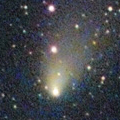
|
It brightened up to 10.4 mag from June to July (July 22, Ken-ichi Kadota). Now it is fading. Appearing in the morning sky in the Souther Hemisphere. It was originally predicted as 15 mag now. But actually, now it is very faint as 18.4 mag (Jan. 2, Martin Masek). It will never be observable again in the Northern Hemisphere.
Date(TT) R.A. (2000) Decl. Delta r Elong. m1 Best Time(A, h)
Feb. 4 20 25.53 -64 1.2 3.476 2.912 48 19.5 5:30 (329,-31)
Feb. 11 20 47.88 -63 33.2 3.529 2.991 49 19.8 5:25 (329,-31)
|
|
![]()
 C/2021 T4 ( Lemmon )
C/2021 T4 ( Lemmon ) C/2021 X1 ( Maury-Attard )
C/2021 X1 ( Maury-Attard ) C/2021 E3 ( ZTF )
C/2021 E3 ( ZTF ) 77P/Longmore
77P/Longmore C/2021 S3 ( PanSTARRS )
C/2021 S3 ( PanSTARRS ) C/2020 R7 ( ATLAS )
C/2020 R7 ( ATLAS ) C/2021 G2 ( ATLAS )
C/2021 G2 ( ATLAS ) 117P/Helin-Roman-Alu 1
117P/Helin-Roman-Alu 1 73P/Schwassmann-Wachmann 3
73P/Schwassmann-Wachmann 3 119P/Parker-Hartley
119P/Parker-Hartley C/2020 S4 ( PanSTARRS )
C/2020 S4 ( PanSTARRS ) C/2022 E2 ( ATLAS )
C/2022 E2 ( ATLAS ) C/2020 Y2 ( ATLAS )
C/2020 Y2 ( ATLAS ) 204P/LINEAR-NEAT
204P/LINEAR-NEAT C/2021 C5 ( PanSTARRS )
C/2021 C5 ( PanSTARRS ) C/2018 U1 ( Lemmon )
C/2018 U1 ( Lemmon ) 61P/Shajn-Schaldach
61P/Shajn-Schaldach C/2022 A3 ( Lemmon-ATLAS )
C/2022 A3 ( Lemmon-ATLAS ) C/2022 L2 ( ATLAS )
C/2022 L2 ( ATLAS ) 116P/Wild 4
116P/Wild 4 263P/Gibbs
263P/Gibbs P/2022 L3 ( ATLAS )
P/2022 L3 ( ATLAS ) 94P/Russell 4
94P/Russell 4 408P/2020 M7 ( Novichonok-Gerke )
408P/2020 M7 ( Novichonok-Gerke ) C/2022 W3 ( Leonard )
C/2022 W3 ( Leonard ) 199P/Shoemaker 4
199P/Shoemaker 4 C/2019 E3 ( ATLAS )
C/2019 E3 ( ATLAS ) 402P/2020 Q3 ( LINEAR )
402P/2020 Q3 ( LINEAR ) C/2020 F2 ( ATLAS )
C/2020 F2 ( ATLAS ) C/2020 H6 ( ATLAS )
C/2020 H6 ( ATLAS ) P/2021 N2 ( Fuls )
P/2021 N2 ( Fuls ) C/2019 O3 ( Palomar )
C/2019 O3 ( Palomar ) C/2014 UN271 ( Bernardinelli-Bernstein )
C/2014 UN271 ( Bernardinelli-Bernstein ) 244P/Scotti
244P/Scotti 280P/Larsen
280P/Larsen C/2021 S4 ( Tsuchinshan )
C/2021 S4 ( Tsuchinshan ) 211P/Hill
211P/Hill P/2021 V2 ( Fuls )
P/2021 V2 ( Fuls ) C/2022 W2 ( ATLAS )
C/2022 W2 ( ATLAS ) C/2020 F5 ( MASTER )
C/2020 F5 ( MASTER ) 452P/2022 B5 ( Sheppard-Jewitt )
452P/2022 B5 ( Sheppard-Jewitt ) 99P/Kowal 1
99P/Kowal 1 C/2022 U4 ( Bok )
C/2022 U4 ( Bok ) C/2021 P4 ( ATLAS )
C/2021 P4 ( ATLAS )![]()

























































